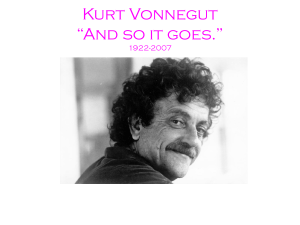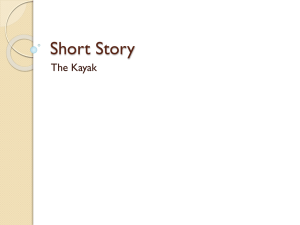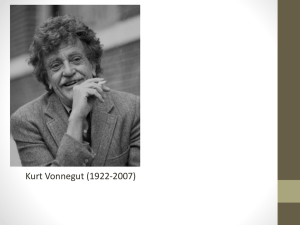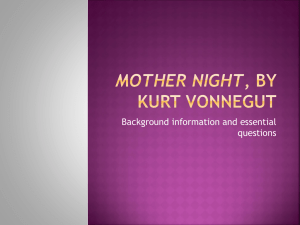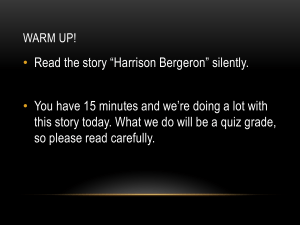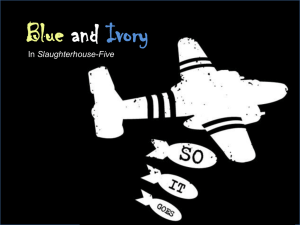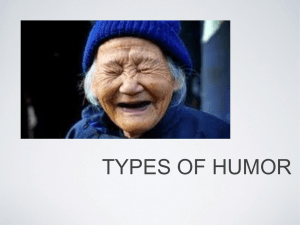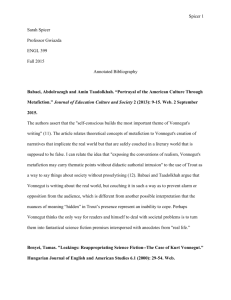A person is shaped by the hardships he faces in life, and must
advertisement
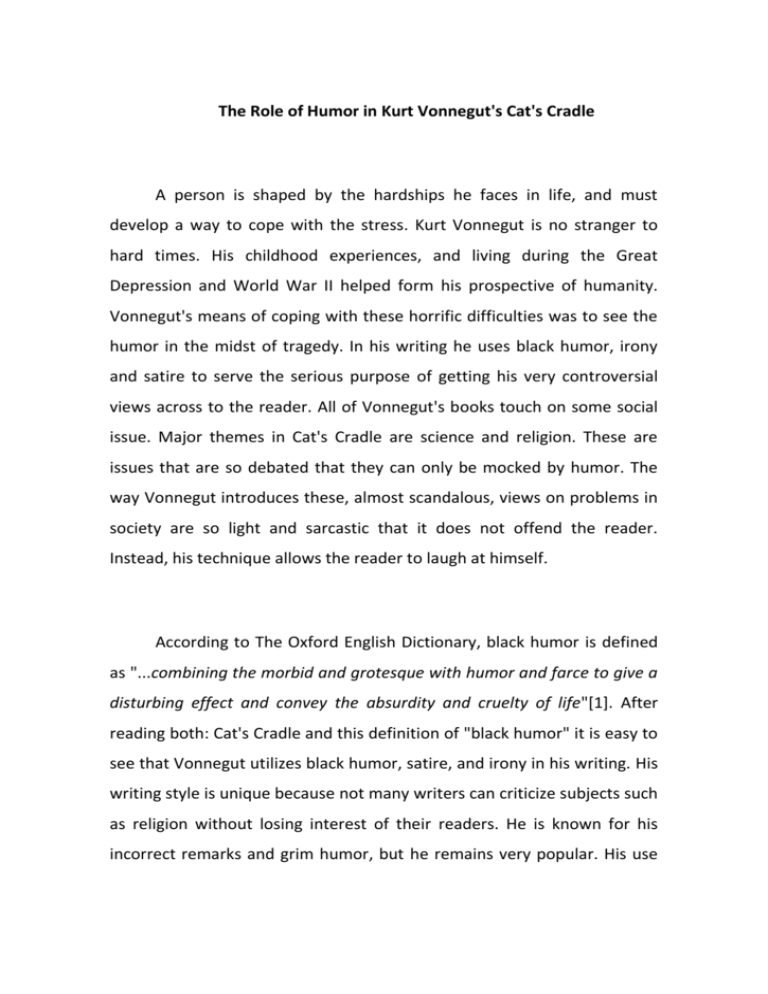
The Role of Humor in Kurt Vonnegut's Cat's Cradle A person is shaped by the hardships he faces in life, and must develop a way to cope with the stress. Kurt Vonnegut is no stranger to hard times. His childhood experiences, and living during the Great Depression and World War II helped form his prospective of humanity. Vonnegut's means of coping with these horrific difficulties was to see the humor in the midst of tragedy. In his writing he uses black humor, irony and satire to serve the serious purpose of getting his very controversial views across to the reader. All of Vonnegut's books touch on some social issue. Major themes in Cat's Cradle are science and religion. These are issues that are so debated that they can only be mocked by humor. The way Vonnegut introduces these, almost scandalous, views on problems in society are so light and sarcastic that it does not offend the reader. Instead, his technique allows the reader to laugh at himself. According to The Oxford English Dictionary, black humor is defined as "...combining the morbid and grotesque with humor and farce to give a disturbing effect and convey the absurdity and cruelty of life"[1]. After reading both: Cat's Cradle and this definition of "black humor" it is easy to see that Vonnegut utilizes black humor, satire, and irony in his writing. His writing style is unique because not many writers can criticize subjects such as religion without losing interest of their readers. He is known for his incorrect remarks and grim humor, but he remains very popular. His use of black humor is clearly marked in the violence, deprivation, and oppression that are used only to show that our society bases on a lie. According to The Oxford English Dictionary, irony is defined as “…the expression of one's meaning by using language that normally signifies the opposite, typically for humorous or emphatic effect”[2]. Irony, perhaps, is the constant of every event and passage in this book. For instance, somehow everyone Jonah comes into contact with and everywhere he finds himself gives him more information about the Hoenikker family. This is ironic because the amount of coincidence in the novel is abnormal and would be almost impossible in real life. Science is seen by humans as 'truth' in the world, and people relate truth with goodness. However, science is what eventually destroys mankind in Cat's Cradle. So, obviously science is not such a great thing after all. Perhaps this means that the truth science helps us to discover that we needn’t know so much unnecessary things. Vonnegut writes about scientists in a way that permits the reader to see the author’s attitude to the profession of scientists. The idea of 'truth' terminating human life in itself is ironic, and the reader should be able to laugh about such ridicule. Vonnegut also attempts to show that scientists have no morals, and this is not too strained of an idea, especially after Dr. Hoenikker asks, "What is sin?"[6]. Davis says it perfectly when he states, "Hoenikker represents Vonnegut's greatest fears: a man who has a mind so brilliant that he can find the means to destroy the world, but who has no conception of right or wrong, of moral value"[3]. How can scientists be such intelligent beings and able to come up with brilliant innovations, but they are unable to grasp the concept of morals? Furthermore, Vonnegut thinks that scientists are childish. He does this by showing how easily manipulated Dr. Hoenikker is. For example, for a while Hoenikker was obsessed with watching his pet turtles, and stopped working on the atom bomb. So, in order to get him back to work, coworkers from the Manhattan Project broke in his house and stole his turtles [6]. Vonnegut pokes fun at religion several times throughout the novel. Vonnegut's ingenious way of satirizing religion makes it significantly less offensive. By creating his own religion, Bokononism, he is able to show the wickedness of religion. If Vonnegut was to criticize Catholicism or Orthodoxy, for example, he would offend and therefore lose interest of his Catholic and Orthodox audience. So, by using Bokononism, Vonnegut is able to oversimplify the ridiculousness of religion. Strange odd ritual in Bokononism is Boko-maru. The Boko-maru is a Bokononist ritual for "the mingling of awarenesses" [6]. It consists in two people extending their legs, thrusting their arms behind them for support, and touching their bare feet together [6]. It is absurd to think that you can actually gain knowledge or get better acquainted with another human by placing the soles of your feet together. The irrationality allows the reader to compare Bokononism with existing religions, and rather than offending the reader he is able to laugh. Vonnegut is trying to show the reader how eager individuals are to achieve the purpose and feel better about life that they look to religion; even if it only offers false hope and lies. Overall, Vonnegut criticizes disputable topics using irony and satire in the novel Cat's Cradle. The long history and universality of the novel makes it a perfect symbol for all of humanity's varied attempts to structure the world in a meaningful way, including magic, religion, fiction, philosophy, and science. Society has constructed various pillars (science and religion) to protect us from the unknown. Kurt Vonnegut uses satire to tear these pillars down. The use of humor is key because it grants Vonnegut the ability to discuss the subjects of his choice without losing the interest of his audience. Vonnegut's writing reflects a dark view of humanity which can only be mocked by humor. The humor is not put forward to cover up the serious themes, but, rather, to further them. Vonnegut prevents the reader from warming himself with lies and gives a comical yet ruthless way to bestow upon the reader thoughtfulness. He aims to show society just how backward it's thinking is, and he accomplishes this goal in Cat's Cradle. Works Cited 1. “Black humor.” def.2. The Oxford English Dictionary. 2nd edition. 1989. 2. “Irony.” def.2. The Oxford English Dictionary. 2nd edition. 1989. 3. Davis, Todd. “Kurt Vonnegut's Crusade, Or How a Postmodern Harlequin Preached a New Kind of Humanism.” Albany State University of New York. 4. Holland, Thomas. “Vonnegut's Major Works: Notes, Including Life and Background, Introduction to the Works, Discussions...Special Topics and Review Questions.” Albany State University of New York Press 2006: 5-33. Net Library. 18 Nov 2008. 5. Marvin, Thomas. “Kurt Vonnegut: A Critical Companion.” Greenwood Press 2002: 1- 40. Net Library. 18 Nov 2008. 6. Vonnegut, Kurt. “Cat's Cradle.” New York: The Dial Press, 2006.

